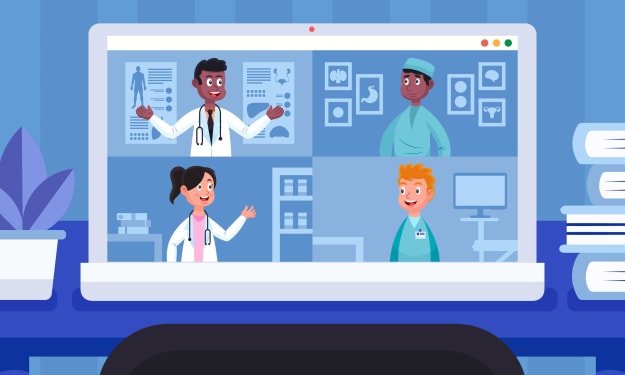How WebRTC Development Solutions Works and Its Applications
WebRTC Development Solutions

The digital age has ushered in a new era of communication, where real-time interactions have become the norm rather than the exception. One of the technological pillars supporting this shift is WebRTC (Web Real-Time Communication). WebRTC development solutions offer a robust framework for integrating real-time communication capabilities directly into web and mobile applications. This article delves into the workings of WebRTC development solutions, its applications, and why it is a game-changer in the realm of digital communication.
What is WebRTC?
WebRTC is an open-source project that provides web applications and websites with the ability to capture, stream, and share audio and video data in real-time. Developed by Google, WebRTC enables peer-to-peer communication, allowing users to interact without the need for intermediaries like servers, which significantly reduces latency and enhances the user experience.
How WebRTC Works
Core Components
WebRTC’s functionality revolves around three main APIs:
- getUserMedia(): This API captures audio and video from the user's device, making it available for streaming.
- RTCPeerConnection: This handles the establishment and management of the peer-to-peer connection. It takes care of signal processing, bandwidth management, and network traversal.
- RTCDataChannel: This facilitates the direct exchange of arbitrary data between peers.
Signaling Process
Before peers can start exchanging data, they need to discover each other and establish a connection, a process known as signaling. While WebRTC does not specify the signaling method, it typically involves:
- Session Description Protocol (SDP): Used for describing multimedia communication sessions.
- Interactive Connectivity Establishment (ICE): A framework to handle network traversal.
- STUN and TURN Servers: Used to facilitate connectivity through NAT and firewalls.
Data Transmission
Once the signaling process is complete, WebRTC uses Secure Real-Time Protocol (SRTP) for audio and video data, ensuring encrypted and secure communication. The real-time communication is managed by the RTCPeerConnection API, which dynamically adjusts to network conditions to maintain quality.
Applications of WebRTC
WebRTC’s versatility has led to its adoption across various industries. Here are some of the key applications:
- Video Conferencing : One of the most prevalent uses of WebRTC is in video conferencing applications. Platforms like Zoom, Google Meet, and Microsoft Teams leverage WebRTC to provide seamless video communication. The ability to handle high-quality video streams with minimal latency makes WebRTC an ideal choice for virtual meetings, webinars, and online classes.
- Telehealth : The healthcare industry has increasingly adopted telehealth solutions, especially in the wake of the COVID-19 pandemic. WebRTC enables doctors to conduct virtual consultations with patients, providing a secure and efficient way to offer medical advice and monitor health conditions remotely. The encryption and low latency of WebRTC ensure that these interactions are both secure and real-time.
- Online Gaming : Real-time communication is critical in online gaming, where players need to interact with each other quickly and efficiently. WebRTC’s low-latency data channels are perfect for multiplayer games, enabling voice chats, live video streaming, and real-time data synchronization between players.
- Customer Support : WebRTC can enhance customer support services by allowing direct audio and video calls from within a web application. This capability is especially useful for businesses that require face-to-face interaction to resolve complex issues or provide personalized assistance. It can also be integrated with chatbots and AI to offer a more comprehensive support system.
- Live Streaming : WebRTC is also used in live streaming platforms, such as social media live streams, live auctions, and online events. Its ability to stream high-quality video with minimal delay makes it a preferred choice for platforms that require real-time broadcasting.
- Remote Work : The rise of remote work has increased the demand for tools that facilitate seamless collaboration. WebRTC-based solutions allow for real-time document editing, video conferencing, and screen sharing, making it easier for teams to work together irrespective of their geographical locations.
Advantages of WebRTC
- Low Latency : WebRTC is designed to provide low-latency communication, which is crucial for applications like video conferencing and online gaming. The direct peer-to-peer connection ensures that data is transmitted quickly and efficiently.
- Security : Security is a significant concern for any communication technology. WebRTC uses encryption for both its signaling and media data, ensuring that all communications are secure from eavesdropping and tampering.
- Cross-Platform Compatibility : Most modern browsers, including Chrome, Firefox, Safari, and Edge support WebRTC. This cross-platform compatibility means that developers can create applications that work seamlessly across different devices and operating systems.
- Open Source : As an open-source project, WebRTC benefits from continuous contributions from developers worldwide. This collaborative effort ensures that WebRTC remains up-to-date with the latest technological advancements and security standards.
- Cost-Effective : By eliminating the need for intermediaries and reducing infrastructure costs, WebRTC offers a cost-effective solution for real-time communication. This makes it accessible for startups and small businesses that might not have the budget for expensive communication systems.
Also Read: What Does WebRTC Web Application Development Include?
Challenges and Considerations
Despite its numerous advantages, there are some challenges associated with WebRTC development:
- Network Variability : The quality of WebRTC communication can be affected by network conditions. Developers need to implement mechanisms to handle issues like packet loss, jitter, and bandwidth fluctuations.
- Browser Compatibility : While WebRTC is supported by most modern browsers, there are differences in implementation that developers must consider to ensure a consistent user experience across all platforms.
- Scalability : For applications requiring large-scale deployments, such as live streaming to thousands of viewers, additional infrastructure and optimization are necessary to manage the load effectively.
Conclusion
WebRTC development solutions are transforming the way we communicate by enabling real-time audio, video, and data sharing directly within web browsers and mobile apps. Its applications span across various industries, including healthcare, gaming, customer support, and remote work, making it a versatile and invaluable tool in the digital age. With its low latency, security, cross-platform compatibility, and cost-effectiveness, WebRTC stands out as a powerful technology driving the future of real-time communication. As the demand for real-time interactions continues to grow, WebRTC is poised to play an even more significant role in shaping the way we connect and collaborate online.
About the Creator
Master Software Solutions
Master Software Solutions is an IT service-based company. We are a team of 90+ IT experts with more than 12 years of experience. We provide development and tech-consulting services for platforms, like HubSpot, Salesforce and WebRTC.
Enjoyed the story? Support the Creator.
Subscribe for free to receive all their stories in your feed. You could also pledge your support or give them a one-off tip, letting them know you appreciate their work.






Comments
There are no comments for this story
Be the first to respond and start the conversation.